1.5 ניקוּד - THE VOWELS OF ISRAELI HEBREW
:
Use with Software Chapter 1:2 "The Vowel Symbols"Before we continue learning the letters of the Alphabet, lets take a look at the vowels.
"The Vowels are Tense". In general it can be said
that Hebrew vowels are "tense" i.e., they are pronounced with th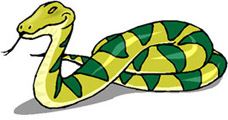 e
muscles of the mouth held firmly and without the tendency to "glide"
from one
e
muscles of the mouth held firmly and without the tendency to "glide"
from one
vowel to another that is common in American English. Consider the English word
real /ree-ahl.Many of us pronounce two separate vowels in that word. An Israeli would say /rihl/.
Hebrew has five vowel sounds:
/ah/ as in "father"/
eh/ in between the ai of "bait" and the e of bet/
ih/ the sound which is between the i of bit and the ee of beet. At the end of a word, especially where there is a /yood/ at the end of the word, or or in a stressed syllable, the sound will be more like /ee/ and we will write /i/ rather than /ih/ to indicate that it is closer to /ee/.ih
/ to indicate that it is closer to /ee/ ./
oh/ as in "shore"/
oo/ the sound which is between the u of "put" and the oo of "boot".1.5.1 ניקוד Say "ah"
 I
I
ר
= /rah/ ש / = /shah ב = /bah/
Reading hint: But in beginners texts, Hebrew poetry or Hebrew prayer books, the vowel symbols for the /
ah/ sound are included under a consonantal letter.For example:
לֳ שֲ בַּ בָּ רַ רָPractice writng these letters: Say the sound the letters make as you write them.
ש ל בּ ב ר ם
![]()
11
1.5.2 ניקוּד - ו : /oh/
Remember: When a Hebrew syllable contains the vowel sound /
oh/, then the vowel sound /oh/ is usually indicated by the letter vahv ו (in Modern Hebrew) written to the left of the consonant. Thus /sh/ ש + the letter /vahv/ ו = /shoh/ שוFor example:
/
roh / = רו /shoh/ = שו /boh/ = בוWrite the syllable /
roh/_____________________________ start here
Write the syllable /
shoh/__________________________ start here
Write the syllable /
boh/______________________________ start here
When nikkud is used, the vowel sound /
oh/ can also be indicated by a small dot at the top left side of a letter. For example: בֹר, רֹב
Practice reading single syllable words.
100.00 %
בר שר רם בּור
שור רב שב לש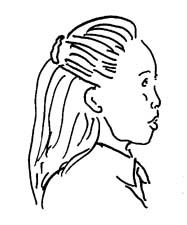
1.5.3 ניקוּד ו /oo/
The vowel sound /oo/ is indicated by the letter /vahv/ ו with a dot to its left ו placed after the consonant. Thus /sh/ ש + a dotted vahv ו = /shoo/ שוּ .
שוּ
= /shoo/Here is a way to remember that the /vahv/ can stand for the sound /OO/
Remember, the symbol
ו is placed to the left of the letter.Note the dot is placed above its mid-point.
For example:
roo =
רוּ shoo = שוּ boo = בוּ12
![]()
Write the syllable "
roo"__________________________ start hereWrite the syllable "
shoo"______________________ start hereWrite the syllable "
boo" __________________________ start hereִ1.5.4 ניקוּד אֶ אֵ
The vowel sound /
eh/ is indicated by either two or three dots placed under the consonant. Both שֶand שֵ are pronounced /sheh/. The /eh/ sound is mid-way between the /ai/ of the English word pain and the /e/ of pen.Here are the vowel symbols (nikkud)
for the sound of /eh/ שֶ שֵ
JUST TWO OR THREE DOTS - IT'S ALL THE SAME TO ME 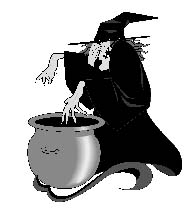
שֶ שֶ שֵ sheh sheh sheh !
These dots are omitted when nikkud is not used.
100.00 %
Write the word "Name" /shehm/__________________ שֵם
Write the word /shehl/___________________________ שֶל
Write the word /lehv/_____________________________ לֵב
Write the word /shehv/____________________________
שֵבThe letter mehm = מ /m/
1.5.5We are adding another letter before we learn more
vowels.
![]()
Practice writing mehm _________________________________________
מWrite the word /sheh-mehsh/___________________________________
שֶמֶשWrite the word /mool/__________________________________________
מוּל
13
1.5.6 נוקיד The Sheva
Here is a bright idea for noting when there is no vowel at all: Two
dots placed vertically under a letter indicate the lack of a vowel. When
you see a shva![]() /
/
Wr ite the following examples, with the /shva:
ite the following examples, with the /shva:
100.00 %
בְּרו
____________________________________/bro/שְבוּ
___________________________________/shvoo/שמְרוּ
________________________________/sham-roo/
When you see two dots (like a colon) below a letter at the end of a syllable, just pronounce
th![]() e
sound of the letter itself: For example:
e
sound of the letter itself: For example:
Write the following examples of words with the /shva/:
שבְרוּ
_____________________/shav-roo/שמְרוּ
____________________ /sham-roo/
1.5.7 קְריאה: The sound of /ih
1.5.7.1י = "ih"
The use of yood
י to indicate the vowel sound /ih/. For example: song - /shihr/ שיר .This short little letter has two jobs. The
י
is the Hebrew symbol for the
consonantal sound of /y/ (to be taught later). However, the
symbol
י
placed to the left of a consonant is
also used to indicate the vowel sound /ih/
or /i/.
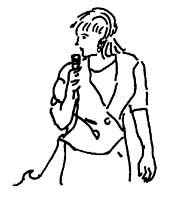
100.00 %
Write:
MY NAME IS .... /shmee/_______________________ שְמי
Write the name "Mira"___________________________
מירהWrite: My name is Mira. ______________________________

14
Thus a consonant, for example /
sh/ + (followed by) the letter yood = /shih/ שי - is placed to the left of the letter ב = בי /bih/. In the word שיר the ש is followed by the letter /yood/ י to indicate that the vo
Now write the Hebrew word for song____________________________________.
שיר
1.5.8 תרְגילֵי קְריאה
These exercises may be done as group work or individually![]()
Circle the segment that is the exact transliteration of
the Hebrew. The focus is on establishing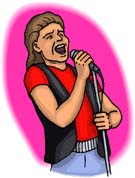
100.00 %
שוּר d. shohr c. shoor b. sheer a. rohsh
בוּר
d. vohr c. voor b. bohr a. boorבי
d. boo c. voh b. boh a. beeרוש
d. rohsh c. roosh b. dohsh a. reeshבוּש
d. vohsh c. bohsh b. voosh a. boosh
1.5.9 עבודה בִקְבוּצות: GROUP WORK "PUZZLER"
![]()
Draw a line matching these Hebrew words with their phonetic transcriptions
1
. שיר 4. בוּר /rihr/ /shoov/2.
ביר 5. שר /shar/ shihr/3
. ריר 6. שוּב //boor/ /bihr/
1.5.9.1 לִ /ih/ - /lih/
There is another symbol used for the sound /
ih/, a single dot* that is placed below the consonant. For example: /bih/ - בִ , /lih/ - לִ, /mih/ - מִ . We will use this symbol most frequently to signal the /ih/ vowel of a prefix. לִשְמור
Now write the Hebrew word /lihsh-mohr/.____________________________
לִשְמור* This dot is omitted when nikkud is not used
15
הֶעָרָה
FYI לידיעתך
In this book we will print the symbols for the /eh/ vowel when a word is first introduced. Later we will omit them. However in an authentic text the reader must decide if the vowel in the syllable is /ah/ or /eh/.